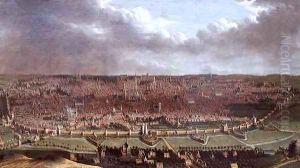Jan Baptist Bonnecroy Paintings
Jan Baptist Bonnecroy was a Flemish painter known for his cityscapes and landscapes. Born in 1618 in Antwerp, which was then part of the Spanish Netherlands, Bonnecroy was a product of the rich artistic environment that thrived in Antwerp during the 17th century. Although not as widely known as some of his contemporaries, his work provides valuable insights into the urban and rural settings of his time.
Bonnecroy's career unfolded during the Dutch Golden Age, a period when art, science, trade, and the military were flourishing in the Netherlands. This was also a time when landscape painting was becoming increasingly popular, with artists such as Bonnecroy contributing to the genre's development. He was primarily a painter of cityscapes, and his works often depicted realistic views of cities, imbued with a sense of accuracy and attention to detail.
Little is documented about Bonnecroy's training or personal life, but it is believed that he was a member of the Guild of Saint Luke in Antwerp, an association of painters, sculptors, and other artists, as well as artisans related to the art world. His membership in the guild suggests that he was a respected artist among his peers.
Bonnecroy's paintings typically feature a high vantage point, allowing for a sweeping overview of the cityscape. His work is characterized by meticulous architectural renderings and a clear understanding of perspective. One of his most notable works is a large panoramic view of Antwerp, which is both informative and aesthetically pleasing. His landscapes, on the other hand, are less known but still display his skill in capturing the natural environment.
Jan Baptist Bonnecroy's death occurred in 1676. Despite his obscurity compared to other Flemish painters of the era, his surviving works continue to be studied for their contribution to the cityscape genre and for their portrayal of 17th-century Flemish urban and rural life.
